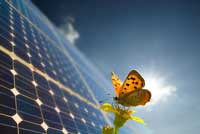
There
are three technologies that make use of the sun’s energy: photovoltaic
cells, which generate electricity directly; thermal, where an absorption
media such as water or oil transfers the absorbed heat to a steam generator
that drives a turbine; and solar towers, which are effectively chimneys
where rising hot air powers turbine generators.
One version of the thermal technology directs the heat from the sun
onto a Stirling engine connected to a generator.
The Stirling engine is an external combustion engine. No combustion
takes place internally so the gases used inside the cylinders never
leave the engine. This means there are no exhaust valves that vent high-pressure
gases, as in a gasoline or diesel engine, and there are no explosions
taking place. This makes Stirling engines very quiet.
The engine uses an external heat source to raise the temperature of
a fixed amount of gas in the cylinder, which increases the internal
pressure and drives a piston.
A changeover valve releases the pressure and a second cylinder takes
over, returning the first to its starting position.
External combustion engines are often less compact and less powerful
than internal combustion engines but can be more efficient.
Thermal techniques use arrays of sun-tracking parabolic reflectors,
called heliostats, perhaps in the form of troughs, to focus the sun’s
rays on an absorber tube filled with oil or other fluid and mounted
on a tower. The hot oil boils water to produce steam, which is used
to generate electricity via a turbine.
An early US demonstration plant, Solar One, a 10MW facility in Barstow,
California, used water as the fluid that generated steam. The plant
was later converted to Solar Two, which used molten salt as the fluid.
The hot salt could be stored, then used when needed later to boil water
into steam to drive a turbine. Since 1985, nine power plants in the
Mojave Desert in Southern California, called the Solar Electric Generating
Systems (SEGS), have been in full commercial operation. They use parabolic
trough technology to collect the sun’s energy.
The system generates steam at 400°C which drives turbines that output
a total of 345MW of electricity for over half a million residents, saving
over 2million barrels of oil a year. The plants range in size from 14
to 80MW and are located on three sites. Each plant sells power to the
local utility, the Southern California Edison Company. Solel Solar Systems
took over the system some time ago and has since further advanced the
technology.
Developments
Reflectors traditionally use aluminium or silver on the front or back
surface of a thin glass or plastic substrate. Today, researchers are
developing new reflective materials, such as advanced polymer films,
that are less expensive to produce than glass. Thin versions are stretched
across a drum and a partial vacuum draws the film into the required
parabolic shape.
Over the past 15 years thermal efficiency has improved by 20percent
as a result of continued research and development into selective coating
technologies and improvements in the glass-to-metal welding of the collectors,
says Solel Solar Systems.
The company claims world leadership in the development and manufacture
of solar thermal collectors ranging from high temperature, 400°C,
parabolic troughs to heating and cooling solutions for residential housing.
It is set to build a US$1bn 500MW solar power station in Israel. It
says one rule of thumb is that the basic foot print for a 10MW/hr solar
thermal plant is 1km square.
What is claimed as the world’s largest solar photovoltaic system
has just been commissioned. Bavaria Solarpark, in Muehlhausen, Germany,
can generate 10MW of electricity from 57600 photovoltaic panels spread
over three sites totalling 62 acres.
The solar electric system was designed and furnished by PowerLight Corporation,
using its patented tracking system which follows the sun to make maximum
use of its energy.
The solar power plant was built on fallow fields formerly used for agricultural
purposes. But the area still provides ecological benefits as herds of
moorland sheep graze the pastures and keep the grass short under the
solar electric panels. Extensive vegetation areas were planted to enhance
the integration of the project site into the surroundings.
In Australia, solar towers are being developed by EnviroMission, a newly-listed
public company committed to establishing profitable, large-scale renewable
energy power stations. The company owns the exclusive licence to German-designed
solar tower technology in Australia and its first project will focus
on developing this revolutionary technology.
The company says the project is on track to get approval by the Australian
government and, on completion, the US$800million solar tower will be
the tallest man-made structure in the world. It will generate enough
electricity to supply 200000 typical Australian homes.
Towering heat
Solar towers use the sun’s radiation to create a constant thermal
updraft of heated air to drive turbines that generate clean sustainable
electricity. The radiation heats the body of air under a large collector
canopy to 35°C above ambient.
The hot air rises up the tower, effectively a chimney, at 15metres per
second, passing through large turbines positioned at the base of the
tower to generate electricity. The scheme envisages using 32 pressure
staged turbines each generating 6.25MW.
The technology has been tested with a successful small-scale pilot plant
constructed in Manzanares, Spain as the result of collaboration between
the Spanish Government and the German designers, Schlaich Bergermann
and Partner. It operated for seven years between 1982 and 1989, and
consistently generated 50kW output of green energy.
The collector zone will be roofed with a translucent material such as
glass or polycarbonate and will be approximately 5km in diameter. The
collector surface is raised several metres above the ground at the edge,
rising to a greater height at the base of the tower. This design facilitates
an environment for air to be directed in vertical movement with minimum
friction loss.
The ground under the collector can also be covered with heat absorbent
tubing or similar material to further increase the plant’s ability
to produce a higher power output over a 24-hour period.
The tower will be constructed from reinforced high strength concrete.
It will be 1000m tall and 150m in diameter as the preferred proportions
for maximum stability and thermal efficiency and can be built using
conventional construction techniques. Its height compares with the television
tower in Toronto, Canada, which is over 600m tall.
Analysis of the lifespan of a reinforced concrete tower in a dry climate
is indicated at more than 50 years. This is because carbonisation, the
usual reason for the deterioration of concrete, does not take place
in low humidity regions.
Carbonisation is the process that causes concrete to lose its ability
to protect its inner reinforced steel due to the gradual conversion
from the surface inwards of calcium hydroxide in the cement into calcium
carbonate as a result of the CO2 present in the atmosphere. This process
is accelerated in the presence of excessive moisture.
Maintenance
The rate of air flow in the tower is sufficiently low to enable maintenance
crews to work inside without shutting down the station.
Its efficiency, the conversion of heat into kinetic energy, is determined
by the difference between the temperature in the collector and the temperature
of the air at the top of the tower. A 1°C drop in temperature over
every 100m facilitates the necessary updraft.
The concept ensures effective operation even on cooler days, as it is
primarily dependent upon the temperature differential between the air
under the collector and air at the top of the tower. The low temperature
differential needed for the tower’s updraft effect ensures the
power station can continue to operate overnight. Heat storage can be
achieved by closing shutters or doors at the base of the tower to trap
the heated air until required.
There are no transport problems bringing fuel to a solar power site,
which make the technology ideal for remote locations.
This also makes it ideal for powering water treatment plants and Acquasol
says a 22MW/hr power plant can produce up to 40gigalitres of potable
water per year from a range of undrinkable sources.
The company says solar thermal technology has large cost advantages
over photovoltaics, wind power and other renewable energy sources. It
can produce high base load power as well as storing thermal energy that
can generate electricity both at night and during periods of poor weather.
Acquasol specialises in green powered water desalination.
The interest shown in large scale solar power is now reaching important
levels and further developments will bring the concept into serious
contention with other methods of generating electricity.
http://www.engineerlive.com/power-engineer/renewable-energy/14429/large-scale-solar-power-plants-addding-to-global-energy-needs.thtml








